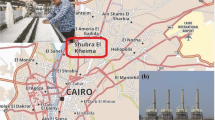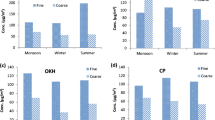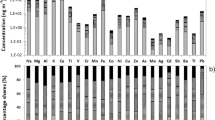Abstract
Aerosol samples collected within an industrial region of Bombay were analyzed for elemental concentrations using inductively coupled plasma emission spectroscopy, ultraviolet/visible spectrophotometry and X-ray fluorescence spectroscopy. Nineteen elements were selected as tracers of identified sources of aerosol in the region. The U.S. EPA chemical mass balance model was employed for source apportionment. Seven major source types were identified and the performance of the model was evaluated at different sampling locations. Model results were unsatisfactory at highly polluted sites in the study regions. It was found that U.S. EPA source profiles are not suitable for such regions in India and site-specific source profiles should be used in the application of chemical mass balance for source apportionment.
Similar content being viewed by others
References
Cheng, Meng-Dawn and Hopke, Philip K.: 1989, ‘Identification of Markers for Chemical Mass Balance Receptor Model’, Atmospheric Environment 23 (6), 1373–1384.
Cornille, Philippe and Maenhuat, Willy: 1990, ‘Sources and Characteristics of the Atmospheric Aerosol near Damascus, Syria’, Atmospheric Environment 24A (5), 1083–1093.
Dzubay, Thomas G. and Stevens, Robert K.: 1988, ‘A Composite Receptor Method Applied to Philadelphia Aerosol’, Environmental Science and Technology 22 (1), 46–52.
EPA-450/4-85-002: 1984, ‘Receptor Model Source Composition Library’, United States Environmental Protection Agency, Office of Air Quality Planning and Standards, Research Triangle Park, NC 27711, U.S.A.
EPA-450/4-87-010: 1987, ‘Protocol for Applying and Validating the CMB Model’, United States Environmental Protection Agency, Office of Air Quality Planning and Standards, Research Triangle Park, NC 27711, U.S.A.
Gordon, G.E.: 1980, ‘Receptor Models’, Environmental Science and Technology 14 (7), 792–800.
Kasahara, Mikio, Choi, Kum-Chan, and Takahashi, Kanji: 1990, ‘Source Contribution of Atmospheric Aerosols in Japan by Chemical Mass Balance Method’, Atmospheric Environment 24A (3), 457–466.
Kowalczyk, G.S., Gordon, G.E., and Rheingrover, S.W.: 1982, ‘Identification of Atmospheric Particulate Sources in Washington D.C., Using Chemical Mass Balance’, Environmental Science and Technology 16 (2), 79–90.
Miller, M.S., Friedlander, S.K., and Hidy, G.M.: 1972, ‘A Chemical Element Balance for the Pasadena Aerosol’, Journal of Colloid and Interface Science 39 (1), 165–176.
Watson, John G.: 1988, ‘Transactions Receptor Models in Air Resources Management’, An International Specialty Conference Sponsored by Air and Waste Management Association, San Francisco, California.
Author information
Authors and Affiliations
Rights and permissions
About this article
Cite this article
Sharma, V.K., Patil, R.S. Chemical mass balance model for source apportionment of aerosols in Bombay. Environ Monit Assess 29, 75–88 (1994). https://doi.org/10.1007/BF00546780
Received:
Revised:
Issue Date:
DOI: https://doi.org/10.1007/BF00546780




